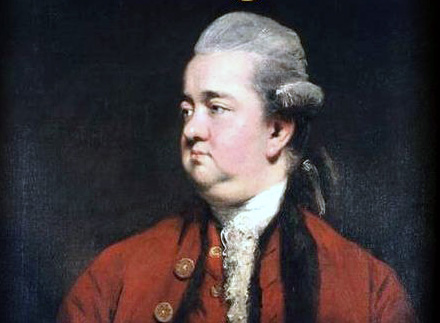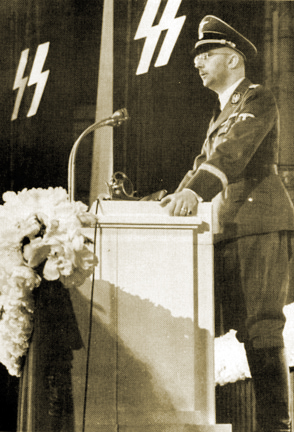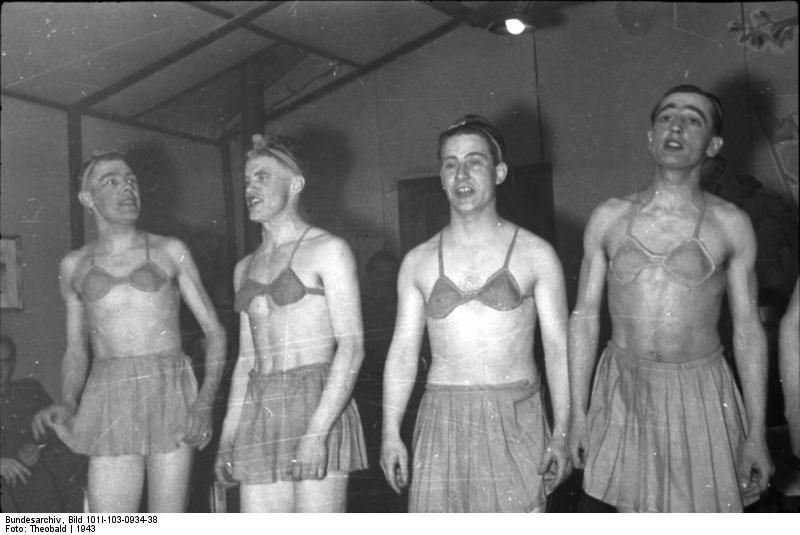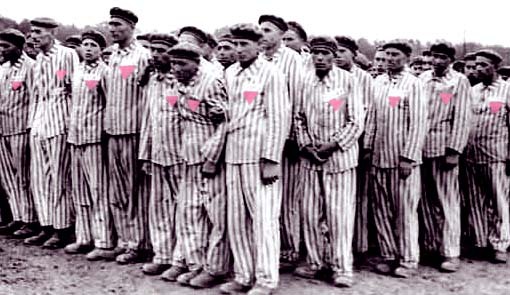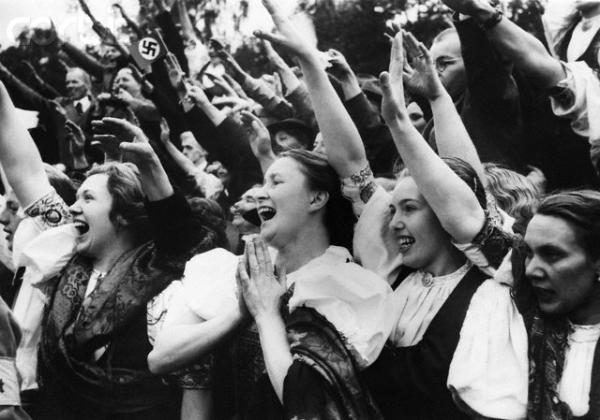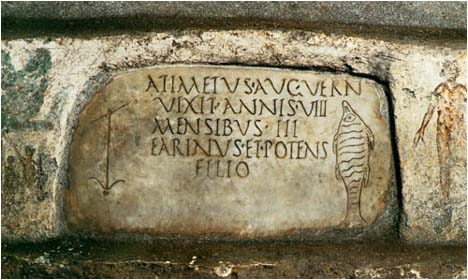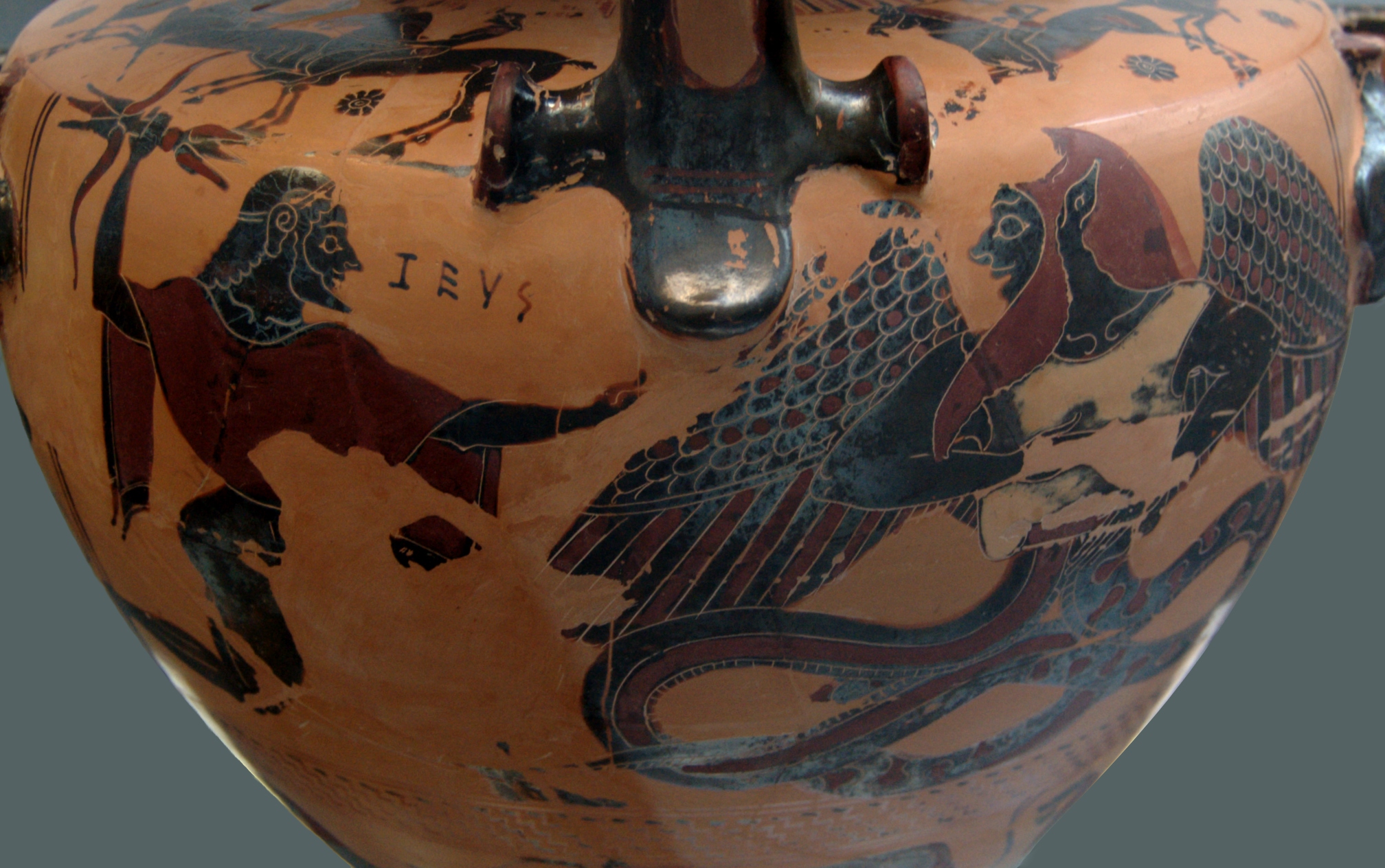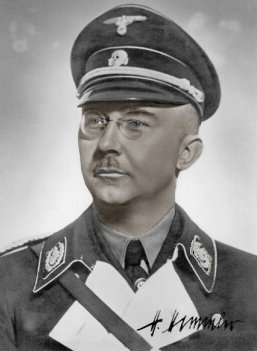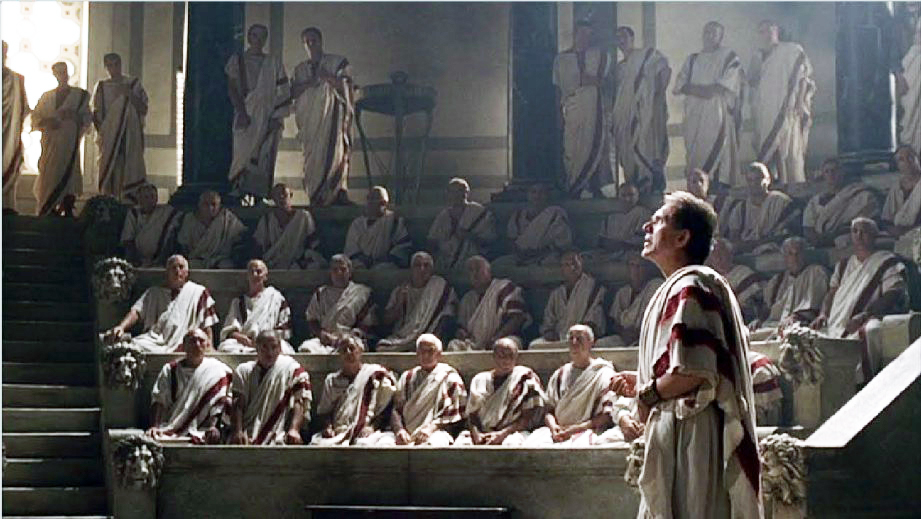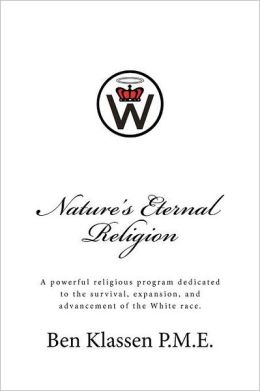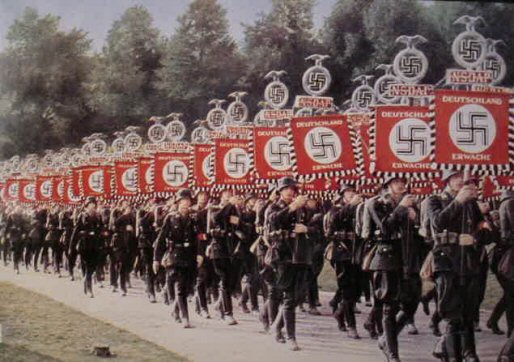
Source: Der Reichsführer SS/SS-
Hauptamt Rassenpolitik (Berlin, 1937).
The development of German culture has not followed a steadily rising course. Decades of no growth are followed by periods of slow but steady progress, then new ideas suddenly appear that transform our culture in fundamental ways. A new view of the world opens up, giving us entirely new ideas of our nature and our environment that can only gradually be investigated. They give our people the opportunity for new growth, new flowering, new possibilities.
The 15th and 16th centuries during the Middle Ages were a period when the Nordic spirit found characteristic expression in the Copernicus’ teaching that the earth revolved around the sun. The earth, which formerly was thought to be the center of the universe, became a small planet that was just as subject to the harmony of eternal laws as the course of the stars. The former world of appearances collapsed, and the Nordic spirit opened the door to a new scientific worldview. As a result of his revolutionary discovery, the worldview the Medieval Church had so successfully built to control people’s minds gradually fell apart over the following centuries. Today’s scientifically-based worldview freed us from the spiritual domination of the priesthood. We owe to it our great advances in technology, the sciences, and economics.
Today we are in the middle of another revolutionary epoch. Revolutionary scientific understandings of genetics and race have found political expression in the National Socialist world view. Once again a world of appearances collapsed, which had concealed from our eyes the true nature of humanity and the connections between body, soul, and spirit.
The foundation of the Christian worldview is the doctrine of the separation of body and soul; the soul and spirit belong to a world independent of the physical, free of natural laws, and they are even to a certain degree able to free the human body from its natural setting.
It is a major shift when racial theory recognizes the unity of body, soul and spirit and sees them as a whole that follows the eternal laws of nature.
A new epoch is coming, one perhaps even more revolutionary than that resulting from Copernicus’s work. Ideas about humanity and peoples that have endured for millennia are collapsing. The Nordic spirit is struggling to free itself from the chains that the Church and the Jews have imposed on Germandom. And it is not only a spiritual battle, for it finds expression in National Socialism’s struggle for power, as well as in today’s battlefields to the east and west. The coming victory will bring a fundamental change in our view of the world, and opens the way for Nordic mankind to a new and greater future.
The enemies of the National Socialist worldview
and their doctrine of the equality of humanity
The Churches
The Christian Church taught the equality of humanity from the beginning, and realized it in the areas it dominated. The Jew Paul was above all responsible for the idea, despite his pride in his pure Jewish ancestry. He won the inhabitants of the Roman Empire for the new faith.
The Roman Empire experienced considerable racial mixing, which encouraged the rapid spread of the doctrine of racial equality. Anyone could become a Christian, whether Roman, Greek, Jew, Negro, etc. As Christians they were all the same, for the important thing was that they belonged to the Church and accepted its teachings. The only differences that counted were those between believers and unbelievers, and between priests and the laity within the Church. Since all men were created in God’s image, all needed to be won for the Church. The goal is a unified humanity united in an all-encompassing Church led by the priests. The clearest expression of this comes in Pope Pius XI’s statement on 29 July 1938: “One forgets today that the human race is a single, large and catholic race.”
This religious doctrine did not come from the native religion of a race or of a racially pure people. It developed in the Orient during a period of racial chaos from the most varied cultures and found its final form under Byzantine influence.

Does the same soul dwell in these differing bodies?
Being absorbed into the Christian community and receiving Christian education did nothing to change or improve the nature or life styles of the various peoples, however. They were only rendered uncertain of their true nature, meaning that foreign influences interfered in areas where only blood should speak, for example the relations between men and women, spousal selection, the relationship between family and people, indeed in relations to foreign customs and life styles.
In over a thousand years, Christianity has not succeeded in raising the cultural level of Negroes or South American Indians. But the Church has built walls where none should exist, for example those between Germans of varying confessions. And it has torn down walls that nature established by blessing marriages between Aryans and Jews, Negroes and Mongols. It took millions of valuable people from their god-ordained roles in the people’s community and put them in monasteries or the priesthood. Its doctrines are responsible for the fall of races, peoples and cultures.
The healthy instincts of the German peoples resisted its foreign teaching from the beginning, or tried to give it its own stamp. Nordic people fought against it for centuries. Meister Elkhart said over 600 years ago: “The divine is in me, I am a part of it; I can recognize God’s will without the help of priests.” Luther told Christians to listen to themselves and act according to their consciences. But the tragedy of the Reformation is that began as a German revolution, but ended in a battle over dogmas, and Luther finally bound the conscience to the Jewish teachings of the Bible.
Copernicus, Kepler, Galileo and many other scientists began the battle between modern science and Church dogma, The Nordic scientific spirit can only accept as true what is in accord with science and experience. Today even the once immovable Church is asking questions about the equality of humanity. The National Socialist worldview, based on the knowledge of the laws of inheritance and the inequality of the races, will succeed in overcoming this ancient false teaching and return the German people to its native worldview.
Liberalism
The French Revolution (1789) introduced Europe to a new guiding idea, summarized in the phrase “Freedom, Equality, Brotherhood.”
It was an uprising of racially inferior elements who took over ideas that in part had entirely different racial origins, and could only be perverted by them. The Jews had a decisive influence.
Like the Church, liberalism taught that all people were equal, that there were no value differences between the races, that external differences (e.g., body type, skin color) were unimportant. Each person, regardless of race, might be a hero or a coward, an idealist or a materialist, creative or useless to society, militarily able, scientifically able, artistically gifted. The environment and education were the important elements that made men good and valuable. If one provided the proper environment and freed people from their chains, the peoples would join to develop their abilities in a unified humanity, and eternal peace would result. Therefore liberalism demanded equality for all, the same opportunities for everyone, in particular the Jews, equality and freedom in the economic sphere, etc.
We Germans have seen where such doctrines lead. Liberalism tore down the structures that held races and peoples together, releasing the destructive drives. The result was economic chaos that led to millions of unemployed on the one side and the senseless luxury of economic jackals on the other. Liberalism destroyed the people’s economic foundations, allowing the triumph of sub-humans. They won the leading role in the political parties, the economy, the sciences, arts and press, hollowing out the nation from inside. The equality of all citizens, regardless of race, led to the mixing of Europeans with Jews, Negro, Mongols, and so on, resulting in the decay and decline of the Aryan race.
All that Nordic civilization had won from the powers of darkness in the areas of culture, science, and freedom was threatened at the instant when the Jews and other inferior elements gained power. European domination of the world collapsed as the result of the World War, and the best of the Germanic peoples, the Germans, faced the danger of decline. Adolf Hitler alone rescued Germany and all of Europe from this fate.
Marxism
The most dangerous opponent of our worldview at present is Marxism, and its offspring Bolshevism. It is a product of the destructive Jewish spirit, and it is primarily Jews who have transformed this destructive idea into reality. Marxism teaches that there are only two classes: the owners and the property-less. Each must be destroyed and all differences between people must be abolished; a single human soup must result. That which formerly was holy is held in contempt. Every connection to family, clan and people was dissolved. Marxism appeals to humanity’s basest drives; it is an appeal to sub-humans.
We have seen firsthand where Marxism leads people, in Germany from 1919 to 1932, in Spain and above all in Russia. The people corrupted by Liberalism are not able to defend themselves against this Jewish-Marxist poison. If Adolf Hitler had not won the battle for the soul of his people and destroyed Marxism, Europe would have sunk into Bolshevist chaos. The war in the East will lead to the final elimination of Bolshevism; the victory of the National Socialist worldview is the victory of Aryan culture over the spirit of destruction, the victory of life over death.
The Jew
The Jews were behind the teachings of equality by the Church, Liberalism and Marxism. They were the first and most fanatic proponents of the idea. The Jew Paul spread the Christian doctrine of equality. Freemasonry dominated the intellectual world of the French Revolution, and Liberalism grew out of Freemasonry. The Portuguese Jew Ricardo, the “father of classical national economics,” is the prophet of the liberal economic theory of free trade and economic piracy. The foundation of Marxism and Bolshevism is Das Kapital, by the Jew Mardochai (Marx).
How did the Jew gain this destructive power over the European peoples? The Jews are a mixed race. The essential characteristic that separates them from all other races and peoples is the instinct for parasitism.
The Jews themselves are most clear about this. Karl Marx, the author of Das Kapital says:
What is the essential trait of Jewry? Practicality, self-interest.
What is the culture of the Jew? Haggling.
What is his God? Money.
The Jewish philosopher Spinoza said: “What we require is simple: that we control everything necessary for our own good.”
The parasitic nature of the Jews is clear in its ability to adjust to the host peoples. A characteristic example is the relationship of the Jew to language: Even before our era the Jewish people had changed its language several times. Wherever they went, they took on the host language, though they were generally unable to conceal their racial additions.
Yet the Jews are one of the most racially conscious peoples. The laws of the Old Testament and the Talmud strongly prohibit marriage with non-Jews. Leading Jews have always stressed the importance of race and racial purity. Even the Soviet Union, otherwise opposed to race, had passed measures to protect Jewish blood.
The most familiar statement comes from the Jew Benjamin Disraeli (originally d’Israeli, later Lord Beaconsfield), the longtime British prime minister:
No one may be indifferent to the racial principle, the racial question. It is the key to world history. History is often confusing because it is written by people who did not understand the racial question and the aspects relevant to it… Race is everything, and every race that does not keep its blood from being mixed will perish… Language and religion do not determine a race—blood determines it.
His parasitic nature led the Jew to hold his own race pure, and to strike other races at the core of their being, their racial nature. Only when a people’s racial purity has been destroyed is the Jew able to develop freely and without restraint.
Disraeli’s political policies prove that many Jews consciously work to destroy racial purity. He made Queen Elizabeth Empress of India, creating an opening in England for oriental life styles. He misled the English people with the notion of an Oriental Empire, thereby dulling and falsifying English racial instincts. The Jew also betrayed the peoples of Russia with images of heaven on earth, leading to race mixing to a vast degree, greatly speeding up a process of decay already in progress.
The Jew could realize his plans for world domination only when Russia had become weak, without instincts, without culture. That is how we understand Mommsen’s description of the Jewish people as the “ferment of decomposition.” As a result, there can never be peace, but only combat, between the Jew and racially aware peoples. Europe will have defeated this threat only when the last Jew has left our part of the planet. The Führer’s words at the beginning of the war will be fulfilled: The German people will not be destroyed in this war, but rather the Jew.
The racial question as the decisive question for our people
Whenever the existence of a people is threatened, the foundation of their development and rise becomes important. The history of every great nation shows a clear idea of its uniqueness and a rejection of foreign races. This attitude is as innate in people as it is in animals. This becomes problematic only when peoples disobey god-ordained laws, when the destructive ideas of equality destroy their instincts, when racial mixing develops. It is then usually too late to turn around, and the decline of the peoples can no longer be stopped. Warning voices were raised in the 18th and 19th centuries when Liberalism began to destroy the peoples of Europe. Gobineau recognized with sure perceptiveness the danger of race mixing. H. St. Chamberlain followed him, as did many others, above all Hans F. K. Günther, who wrote The Racial Nature of the German People.
We owe these Nordic scientists this revolutionary knowledge: Humanity is not equal. Just as plants and animals are of different types, so, too, are people. Each of these types inherits certain characteristics, which distinguish it from all other types, from all other races. Racial differences are physical, spiritual, and intellectual. The most important differences are in the spiritual and intellectual areas, in life styles. Racial science is further supported by advances in genetics. Nordic scientists probed ever deeper into the secrets of life and nature. Gregor Mendel was the first to discover the laws of genetics, opening the way to understanding one of God’s greatest secrets, the nature and continuation of life.
Genetics tells us that characteristics are passed unaltered from generation to generation, and that spiritual and other characteristics are inherited along with physical ones. The environment can only influence what is already present in the genes. Unlike animals, a person does not have a single environment, but also lives in the cultural world of his race and people. This too determines the development of his inherited traits. His culture comes from his inheritance. Therefore, the race to which we belong determines the life we are born into, and the life we pass on.
Racial differences
Races differ not only in their natures, but also in their values. Some races have great creative gifts; others over the centuries never raise themselves above the most primitive level. Think of the fruitful plains of the Ukraine, and imagine what German industry and German ability could have done with them! Compare them with the sandy soil of Mark Brandenburg. The smallest village there displays a culture that towers over Bolshevism’s model cities and collective farms.
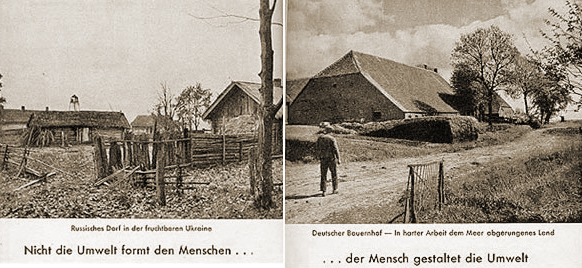
Caption: A Russian Village in the fertile Ukraine,
a German farm on land wrested from the sea.
The environment does not form people…
…people form the environment.
The accomplishments of the Nordic race are the highest of any race in Europe. This is shown in many splendid cultural monuments, not only on European soil, but also deep in Asia and Africa. The investigations are at an early stage, but we already know that there is hardly a nation in North Africa, the Near East, Iran, India and as far as Turkistan that does not show wonderful evidence of Nordic cultures. It must fill us with pride that in our own homeland, in Germany, culture has bloomed in unbroken lines for more than 5000 years, created by people of our blood, our nature, our ancestry.
Race is the decisive force in the life of the peoples
Race is the decisive and molding force in the life of the nations. Language, culture, customs, piety, traditions, life style, but also laws, governmental forms and economies, the whole variety of life is racially determined.
Only racially higher peoples are creators and bearers of a high culture. Only they determine the course of events. Inferior races have no history. They lack the necessary ability, the ability to master their own fate. Only racially advanced peoples have this ability; races that do not have the courage to make history have no history. The life of a people does not develop mechanically, nor does it develop steadily. It is a constant struggle with nature and the environment, and above all with other peoples. It is an eternal battle, an eternal struggle. There is no unified, gradual development of all peoples to a common goal. Cultures rise and fall and peoples vanish without others being able to build on their foundation. Each people have unique racial elements that determine its life style and culture, elements that only it can develop and fill with new life.
Peoples are creative and significant only as long as they preserve and keep pure their racial inheritance. The decline of a people’s culture is always the result of race mixing and a decline in racial quality. Any change in the racial makeup of a people leads to a change in its nature and its culture. If the race that gave a people its nature is debased by mixing with foreign and inferior races, the people’s culture will perish and can never again be restored to full life.
A philosophy that assumes human equality and teaches that all of humanity is part of a common, step-by-step process of development is an error or else a conscious lie. There is no common development of all of humanity. The results of all serious investigations provide evidence against this viewpoint.
Human history is the history of peoples
The history of peoples is racially determined. It is racial in nature.
It is equally false to think that cultures, like individual organisms, follow the laws of growth and decline—that every culture must eventually perish. History provides many examples of peoples that endure for millennia, reaching ever new levels, as long as they maintain their racial purity. Only those peoples perish that ignore their culture—those who act against the law of blood, those that do not maintain the purity of the leading and guiding race.
Since the rise or fall of a people’s culture depends above all on the maintenance, care, and purity of its valuable racial inheritance, every responsible statesman must be concerned with racial policy, and do everything possible to maintain the purity of the racial inheritance for the future. Adolf Hitler was the first statesman in history to recognize this and base his policies on it. The world-spanning war that the German people are waging under his leadership is the battle of the Nordic Race against the forces of chaos and racial decay. It is decisive for the future of our Germanic culture, for the purity of the racial elements that make our culture, and for the fate of Europe as a whole.
The triumph of racial thinking
The new scientific understanding of the importance of blood for the existence of the German people and its culture did not win without a struggle. Our people’s thinking was misled by the forces of the Church, Liberalism, Bolshevism, and Jewry. Only the victory of Adolf Hitler and the National Socialist worldview enabled the German people to think racially. The worldview appeals to the Nordic blood inheritance of each German. We have it to thank for the enormous progress of our people after 1933, and for the unprecedented triumphs of its army in building a new order in Europe and the world. Destroying Jewry will remove the final cause that led to the decline and fall of Europe and its culture.
When National Socialism took power in Germany, most citizens did not understand the revolutionary significance of racial science and genetics. The victory of racial thinking in so short a time is astonishing. Scientific knowledge often requires decades, even centuries, to enter a people’s thinking. The worldview Adolf Hitler developed, based on these incontrovertible scientific results, enabled the greater part of our people to be persuaded of the correctness and decisive significance of racial thinking.
Even in other parts of the Germanic world where the influence of Liberalism has been the strongest and most persistent (e.g. Sweden ) people are realizing the historical significance and value of common Nordic blood and the importance of keeping it pure. They recognize that even today the North Germanic peoples are endangered.
The other peoples of Europe too, above all our allies, are recognizing the importance of racial thinking. A racial manifesto of leading Italian scientists in Fascist Italy on 14 July 1938 affirmed racial thinking clearly.
The seventh of ten points is: “It is time for Italians to openly affirm racial thinking. Italian racial policy must be Italian in nature, and follow the Aryan-Nordic model.” Point 8 said: “It is necessary to make a clear distinction between the Mediterranean peoples of Europe on the one side and the Oriental and African peoples on the other. Point 9 said: “The Jews are of non-Italian blood.” Point 10 added: “The pure European physical and spiritual traits of the Italians may not be altered. The pure European character of the Italians will be changed by mixing with any other non-European race, which is the carrier of a culture other than the ancient Aryan culture.”
This racial manifesto clearly recognizes the biological differences between the human races, and draws the necessary conclusions from that scientific knowledge. It is not a mere imitation of National Socialist thinking. Its significance is that a second great power, building on its own scientific foundations, recognizes the significance of racial thinking and sees maintaining the purity of its good blood as its most important task.
Practical measures soon followed the manifesto. An example was the 1938 law that banned marriages between Italian citizens and the colored (“colonial subjects”).
Each of Europe’s peoples must return to the source of its existence and affirm its racial uniqueness if it is to be renewed in the way the German people has been under National Socialism.
In recent years, most European peoples have found the will to protect their racial purity against mixing. The Jews are increasingly excluded from economic life, and marriages with Jews are forbidden. Examples are Slovakia, Rumania, Hungary, Croatia, and Bulgaria.
Halfway solutions always prove useless. When any kind of back door is left open, the Jew gets around the intentions of the lawmakers. European nations are increasingly coming to the realization that the Jewish question can be solved only as a racial question, and that only racial thinking consistent with natural laws can guarantee the life and characteristics of the individual peoples.
Adolf Hitler introduced a new era in the history of Europe and the world. A new world is rising. The barriers of centuries are falling. Empires are declining and a new order under the leadership of young people is rising. The spiritual revolution of our age is just as significant. The spiritual and political boundaries have probably never been clearer than they are today. The lines are clear everywhere.
The Second World War is a struggle between two worldviews and two ways of life. Our enemy hates us because we have recognized that the single raw material that cannot be replaced is the raw material that the German people have more of than any other people on earth, our good blood, which is our Nordic inheritance. They hate us because they know that we hold the key to victory, to our future, and to the eternal Reich of all Germans.
Race and people
“The human soul does not exist independent of the body, as the Church teaches. Body and soul are an inseparable unity. The living body is the manifestation of the soul.” We do not want to be the last of a millennia-old advanced culture that ends with us, but rather “members of an unending chain extending from our most ancient ancestors to our distant grandchildren.”

